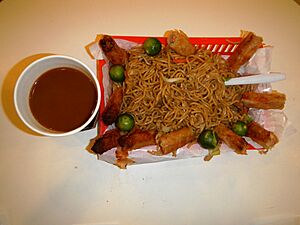Lumpiang Shanghai facts for kids
 |
|
| Alternative names | Filipino spring rolls, Shanghai rolls, Shanghai lumpia, fried pork spring rolls |
|---|---|
| Course | Appetizer |
| Place of origin | Philippines |
| Serving temperature | hot, warm |
| Main ingredients | ground pork, carrots, lumpia wrapper |
Lumpiang Shanghai (also known as Filipino spring rolls) is a yummy deep-fried appetizer from the Philippines. It's made with a mix of giniling (which is ground pork) wrapped in a thin egg crêpe. This dish is considered the most common type of lumpia in Filipino cooking. It's usually smaller and thinner than other kinds of lumpia.
Where Did Lumpiang Shanghai Get Its Name?
Even though it's called Lumpiang Shanghai, this dish doesn't actually come from Shanghai or China. It's a Filipino take on a type of rolled snack. It got its name because it looks a bit like the Chinese spring roll.
The first versions of the wrapper were made from Tortillas, using Spanish corn flour. Later, Chinese people who moved to the Philippines brought their own way of making wrappers from rice flour. This is how the "lumpia wrapper" came to be! The idea of lumpia itself mixes Spanish and Chinese Filipino influences. It was brought over by people from Fujian and during the early Spanish colonial times. However, Filipino lumpia and its wrappers are now unique and thinner than Chinese spring roll wrappers.
What's in Lumpiang Shanghai?

Lumpiang Shanghai is known for using giniling (ground pork) as its main filling. The ground pork is first cooked quickly (called sautéed) with finely chopped carrots, garlic, onions, and shallots. It's seasoned with salt and pepper to taste.
A small amount of this mix is then placed on a lumpia wrapper, which is a thin egg crêpe. The wrapper is rolled tightly around the filling to make a thin cylinder. The ends are sealed by wetting them with a little water or egg whites. Sometimes, raw eggs are added to the cooked pork filling to help it keep its shape better. Finally, the rolls are deep-fried until they are golden brown and crispy.
This dish is often served with agre dulce (sweet and sour) dipping sauce. This sauce really brings out its "Chinese-ness." You can also enjoy it with other popular lumpia sauces. These include banana ketchup, sweet chili sauce, garlic mayonnaise, or vinegar mixed with labuyo peppers and calamansi.
Lumpiang Shanghai is one of the most common dishes at Filipino parties. It's often served alongside different kinds of pancit (noodles). People usually prepare them ahead of time and store them in the refrigerator. They are then deep-fried right before it's time to eat them.
Different Kinds of Lumpia
The basic recipe for Lumpiang Shanghai can be changed easily. Many different versions exist! However, if a variation doesn't use ground pork as its main filling, it's usually just called "lumpia" in general.
Some common changes include using ground beef, ground shrimp, or shredded chicken instead of pork. Other ingredients can also be added to the filling. These might include green peas, raisins, cheese, peppers, milk, water chestnuts, singkamas (jicama), and kintsay (Chinese celery).

